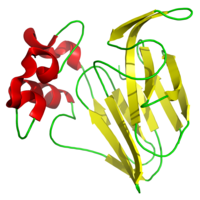Thaumatin
| Thaumatin family | |||||||||
|---|---|---|---|---|---|---|---|---|---|

|
|||||||||
| Identifiers | |||||||||
| Symbol | Thaumatin | ||||||||
| Pfam | PF00314 | ||||||||
| InterPro | IPR001938 | ||||||||
| SMART | SM00205 | ||||||||
| PROSITE | PDOC00286 | ||||||||
| SCOP | 1thu | ||||||||
| SUPERFAMILY | 1thu | ||||||||
| OPM superfamily | 189 | ||||||||
| OPM protein | 1aun | ||||||||
| CDD | cd09215 | ||||||||
|
|||||||||
| Available protein structures: | |
|---|---|
| Pfam | structures |
| PDB | RCSB PDB; PDBe; PDBj |
| PDBsum | structure summary |
| Thaumatin I | |
|---|---|
| Identifiers | |
| Symbol | THM1_THADA |
| PDB | 1RQW More structures |
| UniProt | P02883 |
| Thaumatin II | |
|---|---|
| Identifiers | |
| Symbol | THM2_THADA |
| UniProt | P02884 |
Thaumatin is a low-calorie sweetener and flavour modifier. The protein is often used primarily for its flavour-modifying properties and not exclusively as a sweetener.
The thaumatins were first found as a mixture of proteins isolated from the katemfe fruit ( Bennett) of west Africa. Some proteins in the thaumatin family of sweeteners are roughly 2000 times more potent than sugar. Although very sweet, thaumatin's taste is markedly different from sugar's. The sweetness of thaumatin builds very slowly. Perception lasts a long time, leaving a liquorice-like aftertaste at high usage levels. Thaumatin is highly water-soluble, stable to heating, and stable under acidic conditions.
Thaumatin production is induced in in response to an attack upon the plant by viroid pathogens. Several members of the thaumatin protein family display significant in vitro inhibition of hyphal growth and sporulation by various fungi. The thaumatin protein is considered a prototype for a pathogen-response protein domain. This thaumatin domain has been found in species as diverse as rice and Caenorhabditis elegans. Thaumatins are pathogenesis-related (PR) proteins, which are induced by various agents ranging from ethylene to pathogens, and are structurally diverse and ubiquitous in plants: They include thaumatin, osmotin, tobacco major and minor PR proteins, alpha-amylase/trypsin inhibitor, and P21 and PWIR2 soybean and wheat leaf proteins. The proteins are involved in systematically acquired resistance and stress response in plants, although their precise role is unknown. Thaumatin is an intensely sweet-tasting protein (on a molar basis about 100,000 times as sweet as sucrose) found in the West African shrub : it is induced by attack by viroids, which are single-stranded unencapsulated RNA molecules that do not code for protein. The thaumatin protein I consists of a single polypeptide chain of 207 residues.
Like other PR proteins, thaumatin is predicted to have a mainly beta structure, with a high content of beta-turns and little helix. Tobacco cells exposed to gradually increased salt concentrations develop a greatly increased tolerance to salt, due to the expression of osmotin, a member of the PR protein family. Wheat plants attacked by barley powdery mildew express a PR protein (PWIR2), which results in resistance against that infection. The similarity between this PR protein and other PR proteins to the maize alpha-amylase/trypsin inhibitor has suggested PR proteins may act as some form of inhibitor.
...
Wikipedia
